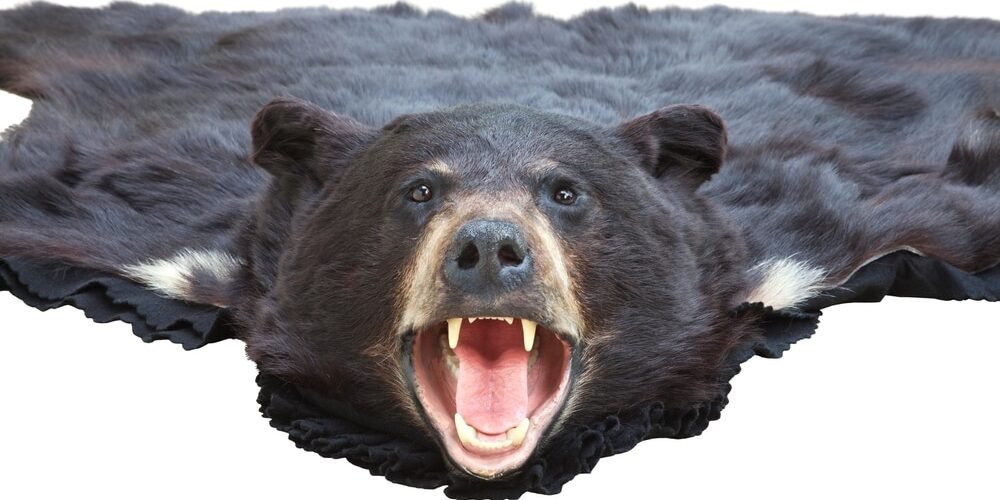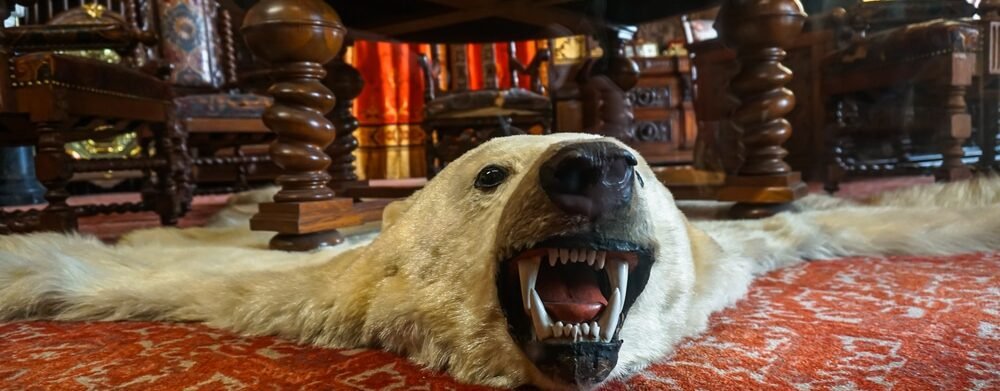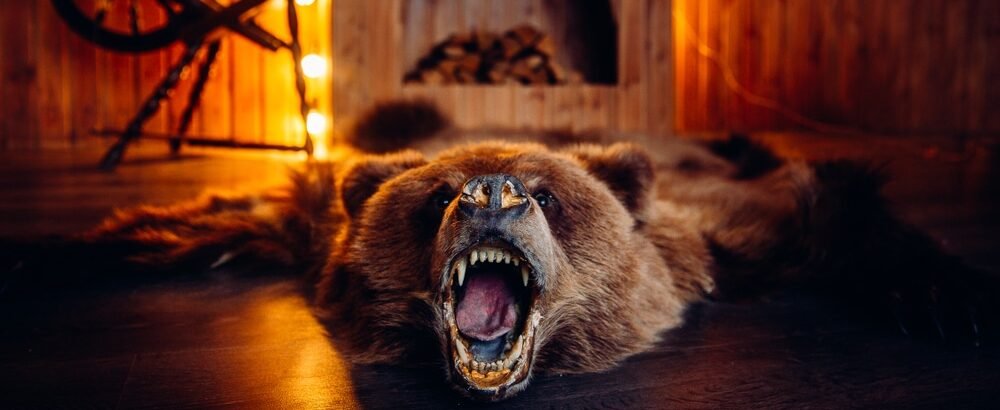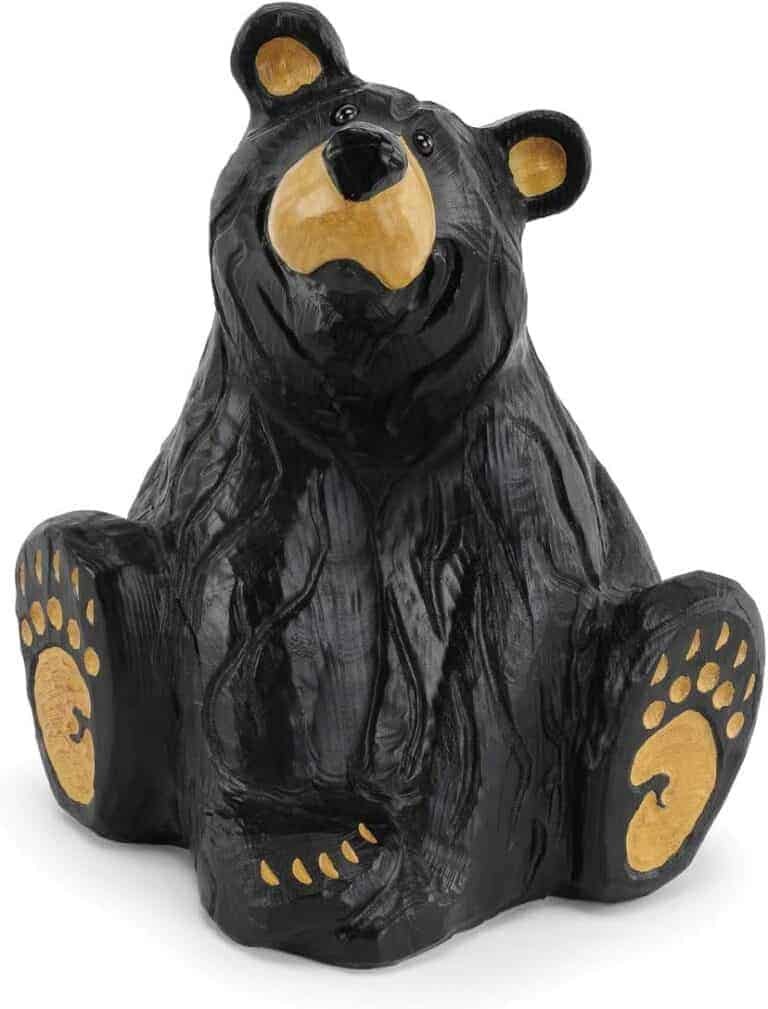The image of a bear rug – a luxurious expanse of fur adorning a grand fireplace – evokes a sense of rustic grandeur. But in today’s world, the ethics surrounding bear rugs are a cause for debate.

This blog post delves into the history, cultural significance, and legal aspects of bear rugs and explores the ethical considerations surrounding their use in modern decor.
The History and Cultural Significance of Bear Rugs
For millennia, bear pelts have transcended mere animal skins, holding deep significance in various cultures across the globe. Here’s a glimpse into the multifaceted role they played:
Symbol of Strength and Status
In many cultures, bears were revered for their power and majesty. A bear rug served as a tangible representation of the hunter’s prowess. Displaying such a prized possession within the household solidified the hunter’s status and courage, a constant reminder of their encounter with a formidable creature.
Warmth and Utility
Beyond their symbolic value, bear rugs offered practical benefits in colder climates. The thick fur provided essential warmth and insulation, making them a valuable household item. Imagine a harsh winter where a bear rug wasn’t just a decorative element – it was a necessity for survival, offering families a shield against the biting cold.
Spiritual Significance
Some cultures attributed a deeper meaning to bear pelts, believing they held the essence of the bear’s strength and spirit. These rugs transcended the material realm, becoming powerful talismans. Owning a bear rug wasn’t just about warmth or status; it was a way to connect with the natural world, seeking protection and channeling the bear’s spirit.
The Modern Debate: Ethics and Legality

The widespread availability of ethically sourced alternatives and the decline of bear populations in some regions have ignited a heated debate about the ethics of bear rugs. Let’s delve into the key arguments on both sides:
Endangered Species Concerns
There’s a clear consensus on this point. Using rugs from endangered or threatened bear species is strictly prohibited and ethically reprehensible. International agreements like CITES (Convention on International Trade in Endangered Species) exist to safeguard these vulnerable populations.
Owning a rug made from an endangered bear is not only illegal, but it contributes to the decline of these magnificent creatures.
Sustainable Sourcing
The debate becomes more complex when considering bear rugs from populations managed through regulated hunting. Proponents argue for a sustainable market in which only a few bear rugs are harvested from healthy populations.
Opponents, however, believe the practice is inherently unsustainable. The potential for illegal hunting and the difficulty of ensuring truly sustainable practices raise concerns about the long-term impact on bear populations.
Alternatives in Abundance
The tide is turning in favor of ethically sourced alternatives. The availability of high-quality faux fur rugs that replicate the look and feel of bear fur has significantly reduced the demand for real fur.
These alternatives offer the same luxurious aesthetic without ethical concerns. With so many beautiful and sustainable options available, there’s no need to contribute to the decline of bear populations for a decorative item.
Navigating the Legal Landscape: Owning a Bear Rug

The legality of owning or selling bear rugs varies depending on your location and the specific species of bear. Understanding the legal framework ensures you’re not only making an ethical choice but also complying with the law. Here’s a breakdown of the key considerations:
International Regulations
International agreements like CITES play a crucial role in regulating the trade of endangered bear species. These agreements establish clear guidelines and permit requirements to prevent the exploitation of vulnerable populations. Any rug made from an endangered bear species is likely to be illegal to own or sell.
Local Laws
Don’t be fooled by international regulations – federal, state, and local laws also play a significant role. Always check the specific laws in your area regarding the possession and sale of bear rugs. Permits or licenses may be required for owning rugs from specific bear species, even if they’re not endangered on a global scale.
Vintage Rugs
The legal landscape gets even trickier with vintage bear rugs. While owning a vintage rug might be legal, selling it could be restricted. It’s crucial to research the specific circumstances and any relevant laws regarding the sale of vintage wildlife products.
Consulting with wildlife authorities or legal professionals can help navigate the complexities of owning or selling a vintage bear rug.
Beyond the Bear Rug: Sustainable and Ethical Alternatives

With a growing awareness of ethical issues and abundant, beautiful, sustainable alternatives, there’s no need to compromise on style for conscience. Let’s explore some fantastic options that allow you to create a warm and inviting atmosphere in your home without harming bears:
Faux Fur Rugs
Technological advancements have made high-quality faux fur rugs indistinguishable from real fur in appearance. These luxurious alternatives come in a variety of styles, colors, and textures, allowing you to find the perfect match for your decor. Best of all, you can enjoy the beauty of a fur rug without the ethical burden.
Woven Wool Rugs
For a natural and sustainable alternative, consider the timeless elegance of wool rugs. Wool offers a similar level of warmth and comfort to fur, and the vast array of colors, patterns, and textures ensures you can find a rug that complements your style. From classic hand-woven kilim rugs to plush contemporary wool options, the possibilities are endless.
Handcrafted Alternatives
Embrace individuality and support artisans by exploring handcrafted alternatives. Sheepskin throws offer a touch of rustic charm, while woven rugs made from natural fibers like jute or hemp provide a unique and eco-friendly touch. These handcrafted options add a personal touch to your space while aligning with sustainable practices.
By opting for these beautiful and ethical alternatives, you can create a warm and inviting atmosphere in your home while celebrating the majesty of bears in their natural habitat. Let’s move beyond the traditional bear rug and embrace a future where style and sustainability go hand in hand.
Conclusion: Embracing Beauty Without Exploitation
The allure of a bear rug is undeniable, but there are compelling reasons to explore alternatives. By understanding the history, cultural significance, and ethical considerations surrounding bear rugs, we can make informed choices prioritizing aesthetics and sustainability.
Beautiful and ethically sourced options are available to create a warm and inviting atmosphere in your home. Let’s celebrate the grandeur of bears while respecting these magnificent creatures and their place in the wild.





I was looking through some of your posts on this internet site and I believe this internet
site is very instructive! Keep posting.Money from blog